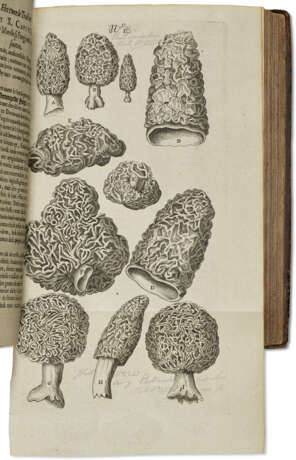ID 1032772
Lot 120 | Theatrum fungorum
Estimate value
$ 7 000 – 9 000
First edition of the first book seriously devoted to the kingdom of fungus, lavishly illustrated and in contemporary Flemish calf. While mushrooms have been used and cultivated by humans since prehistory, even today much about them remains to be understood. The author of the present work was an Antwerp priest and botanist—mushrooms were usually included under the umbrella of "botany," although a century later Linnaeus would class them with worms. He discusses both edible and poisonous varieties, and his text is written in Dutch, making it accessible to a wider group of readers who might benefit from practical knowledge. The elaborate frontispiece by Eduard van Ordonie after Arnold van Westerhout depicts a mushroom market, with garlands of fungus carried by putti and vendors hawking their wares.
It is the first work devoted solely to mushrooms as a category—in this case, also including potatoes, because Sterbeeck thought they were a fungus. The influential botanist Carolus Clusius had included a section on fungus in his Pannonis Observatorum Historia; however, the "original manuscript for this treatise with its eighty-seven original drawings had been lost by the publisher, so they had to use other illustrations for the 1601 edition, and these were quite inaccurate. Afterwards, the lost manuscript reappeared and Sterbeeck used it as a basis for his work, adding much new material of his own" (Hunt). Many of the illustrations here are based on Clusius's fine watercolors; one, plate 31, is copied with acknowledgement from Robert Hooke’s Micrographia of 1665; it depicts the spores of fungi under magnification. A portrait depicts the dedicatee, the anatomist Johannes van Buyten. Nissen BBI 1892; Pritzel 8947; Hunt 341.
Quarto (201 x 156mm). Half title. Engraved frontispiece, folding portrait, and 36 engraved plates, 27 of which are folding or double-page (very faint marginal dampstaining to a few leaves, small stub tear to portrait). Contemporary Flemish calf, spine gilt (upper joint just starting, worn at extremities). Provenance: purchase inscription at end of index giving a date of 12/8/1734, and note of currency and cost – faint manuscript annotations in light pencil to some illustrations, and ‘Hall. Hist.’ followed by a four-digit number (references are to Albrecht von Haller’s 1768 Historia stirpium indigenarum Helveticae inchoate; Sterbeeck is cited in the corresponding entries – old paper circular library label on spine with number 3196.
| Address of auction |
CHRISTIE'S 20 Rockefeller Plaza 10020 New York USA | ||||||||||||||
|---|---|---|---|---|---|---|---|---|---|---|---|---|---|---|---|
| Preview |
| ||||||||||||||
| Phone | +1 212 636 2000 | ||||||||||||||
| Fax | +1 212 636 4930 | ||||||||||||||
| Conditions of purchase | Conditions of purchase | ||||||||||||||
| Shipping |
Postal service Courier service pickup by yourself | ||||||||||||||
| Payment methods |
Wire Transfer | ||||||||||||||
| Business hours | Business hours
|









